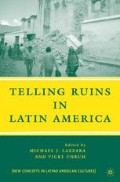Abstract
On the way to Cafayate, somewhere north of Tucumán, the ruined citadel of the Quilmes Indians allows me the leisure of pausing. Perched on the pinnacle of what was once the fortress of a mighty nation, I admire the heights that I have scaled; I stretch my gaze over the horizon; I try to imagine life as it might have been before time swept it all away. Nonetheless, these are not free thoughts, unshackled from any earlier logic. After all, the guidebook has intervened far before my arrival, alerting me to the story of the rise and fall of this once flourishing culture. The largest settlement in Argentina before the Conquest, the Quilmes first resisted the Inca empire and then, for 130 years, opposed the power of Spanish invaders. We know from the tour books that the Spaniards dragged the last Quilmes survivors on foot to Buenos Aires. Most perished in the march. We are also told that the ruins were rehabilitated during Videla’s military dictatorship (1976–1983). Who then can escape the irony of the junta’s gesture, staged in 1978, possibly its cruelest moment, of remembering its native peoples who, much like 30,000 citizens under military rule, had also been disappeared? This is an all-too familiar narrative that runs from Wounded Knee to Tierra del Fuego: first we kill indigenous peoples and later we return as tourists to celebrate their achievements.
Like ossuaries, ruins prove the end of nationalisms and frontiers to which we so laboriously adhere.
—Luisa Futoransky
Access this chapter
Tax calculation will be finalised at checkout
Purchases are for personal use only
Preview
Unable to display preview. Download preview PDF.
Select Bibliography
Benjamin, Walter. “Excavation and Memory.” In Selected Writings, 1927–34, edited by Michael William Jennings, 576. Cambridge, MA: Harvard University Press, 1999.
—. Illuminations. Translated by Harry Zohn. New York: Schocken Books, 1969.
—. The Origin of German Tragic Drama. Translated by John Osborne. London: Verso, 1998.
Bulwer Lytton, Edward. The Last Days of Pompeii. New York: A. L. Burt Company, n.d.
Crary, Jonathan. Techniques of the Observer: On Vision and Modernity in the Nineteenth Century. Cambridge MA: MIT Press [1990], 1995.
De Certeau, Michel. The Practice of Everyday Life. Translated by Stephen Rendell. Berkeley: University of California Press [1984], 1988.
Deleuze, Gilles. “He Stuttered.” In Essays Critical and Clinical, translated by Daniel W. Smith and Michael A. Greco, 107–14. Minneapolis: University of Minnesota Press, 1987.
—. “Mediators.” In Incorporations, edited by Jonathan Crary and Sanford Kwinter, 281–94. New York: Zone Books, 1995.
Edensor, Tim. Industrial Ruins: Space, Aesthetics and Materiality. New York: Berg, 2005.
Freud, Sigmund. “Analysis of a Phobia in a Five Year Old Boy.” In The Standard Edition of the Complete Psychological Works of Sigmund Freud, volume 10, translated by James Strachey, 1–50. London: Hogarth, 1953–66.
Futoransky, Luisa. “Prologue.” In Desaires, with photographs by José Antonio Berni. Madrid: Ediciones del Centro de Arte Moderno, 2006.
Ginsberg, Robert. The Aesthetics of Ruins. New York: Rodopi, 2004.
Gorriti, Juana Manuela. Dreams and Realities. Edited by Francine Masiello. New York: Oxford University Press, 2003.
Huyssen, Andreas. “Nostalgia for Ruins.” Grey Room 23 (Spring 2006): 6–21.
Melville, Herman. Moby Dick, Billy Budd, and Other Writings. New York: Library of America, 2000.
Nora, Pierre. Realms of Memory: Rethinking the French Past. Translated by Arthur Goldhammer. New York: Columbia University Press, 1996.
Piglia, Ricardo. “Sarmiento the Writer.” In Sarmiento: Author of a Nation. A Collection of Critical Essays, edited by Tulio Halperín Donghi, Gwen Kirkpatrick, and Francine Masiello, 127–44. Berkeley: University of California Press, 1994.
Said, Edward. Beginnings: Intention and Method. London: Granta, 1997.
Volney, Constantin-Francois. The Ruins; or, A Survey of the Revolution of Empires. London: Holyoake, [1799] 1857.
Editor information
Copyright information
© 2009 Michael J. Lazzara and Vicky Unruh
About this chapter
Cite this chapter
Masiello, F. (2009). Scribbling on the Wreck. In: Lazzara, M.J., Unruh, V. (eds) Telling Ruins in Latin America. New Concepts in Latino American Cultures. Palgrave Macmillan, New York. https://doi.org/10.1057/9780230623279_3
Download citation
DOI: https://doi.org/10.1057/9780230623279_3
Publisher Name: Palgrave Macmillan, New York
Print ISBN: 978-1-349-37272-0
Online ISBN: 978-0-230-62327-9
eBook Packages: Palgrave Social & Cultural Studies CollectionSocial Sciences (R0)

